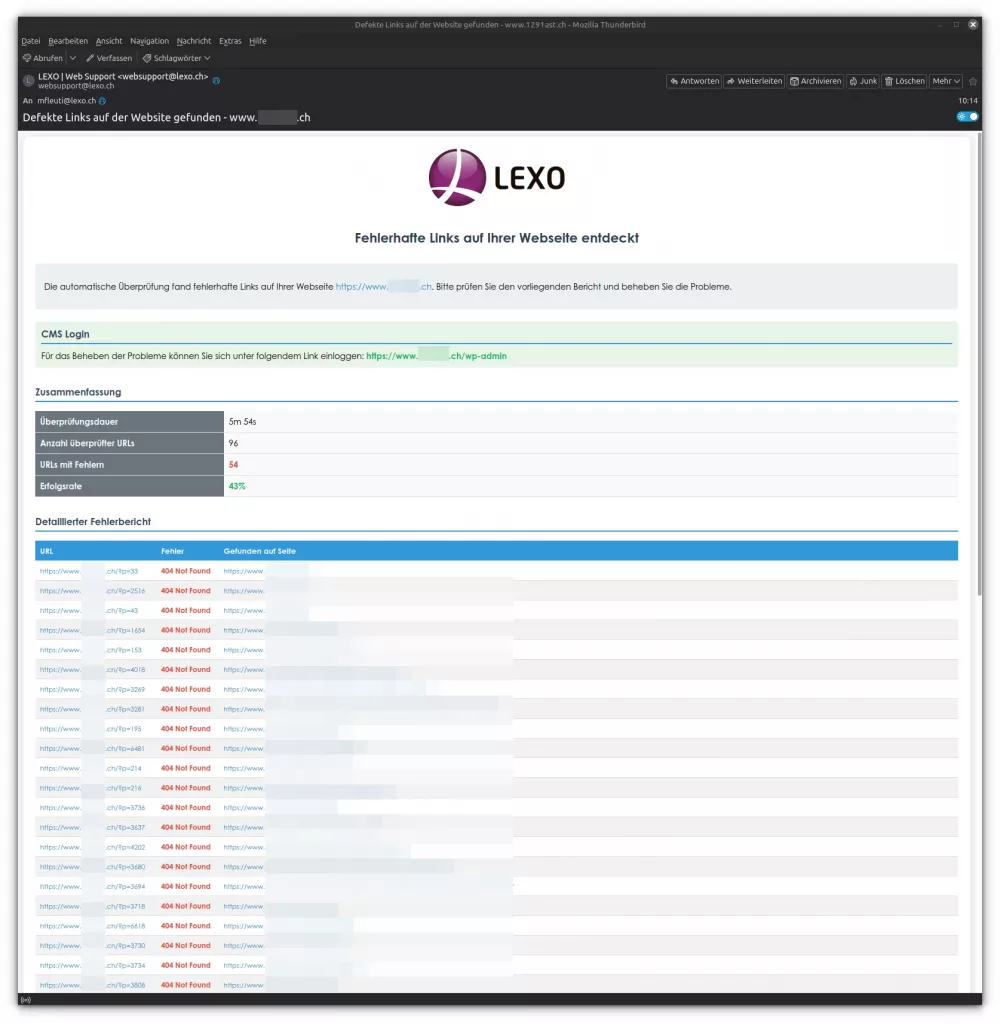
Categories
Money money money...
Could we help you? Please click the banners. We are young and desperately need the money



Free Fully Automated Website Link Checker: Bash Script with HTML Email Reports for Broken Link Detection



Introduction
In today's digital landscape, maintaining website health is crucial for user experience and SEO rankings. Broken links not only frustrate visitors but also negatively impact search engine rankings and overall site credibility. However, modern websites have evolved sophisticated protection mechanisms that make traditional automated link checking increasingly unreliable. CDN services like Cloudflare, AWS CloudFront, and Web Application Firewalls now actively block standard automated tools, creating a new challenge for website monitoring.
This comprehensive guide explores a revolutionary bash script solution that overcomes these modern protection mechanisms using cutting-edge browser emulation technology. Whether you're a system administrator managing multiple websites, a developer maintaining web applications, or a DevOps engineer implementing monitoring solutions, this automated link checker provides unprecedented reliability and performance for the modern web.
What is the LEXO Linkchecker v2.0?
The LEXO Linkchecker v2.0 represents a complete architectural revolution in automated website link validation. Unlike traditional tools that rely on outdated HTTP libraries easily detected by modern protection systems, this solution leverages curl-impersonate technology to mimic authentic Chrome browser behavior, ensuring reliable access to protected websites.
Built from the ground up with the script features parallel processing capabilities, intelligent protection detection, and sophisticated HTML email reporting with white-label branding support. The solution performs comprehensive recursive crawling while respecting modern web protection mechanisms, delivering actionable insights through professional reporting systems.
Revolutionary Protection Bypass Technology
At its core, v2.0 utilizes curl-impersonate-chrome to overcome the sophisticated bot detection mechanisms that plague traditional monitoring tools. This technology replicates authentic browser TLS fingerprints, HTTP/2 behavior patterns, and connection characteristics that allow it to bypass Cloudflare challenges, WAF filtering, and advanced bot detection systems.
Key Features and Revolutionary Improvements
Curl-Impersonate Integration: The Game Changer
Modern websites employ multiple layers of protection that traditional tools cannot overcome:
- CDN Protection: Cloudflare, AWS CloudFront actively fingerprint and block non-browser requests
- WAF Filtering: Web Application Firewalls detect automated tools through HTTP header analysis
- TLS Fingerprinting: Advanced systems analyze connection patterns to identify bots
- JavaScript Challenges: Dynamic protection mechanisms that require browser-like behavior
The curl-impersonate integration solves these challenges by providing authentic Chrome browser emulation, including:
- Real browser TLS fingerprints and cipher suites
- HTTP/2 connection behavior with proper ALPS negotiation
- Authentic header patterns and request timing
- Certificate compression and modern web standards support
Enterprise-Grade Performance Architecture
Version 2.0 features a completely rewritten processing engine optimized for large-scale website monitoring:
# Configurable parallel processing
PARALLEL_WORKERS=20 # Concurrent URL checking workers
BATCH_SIZE=50 # URLs processed per batch
CONNECTION_CACHE_SIZE=5000 # Connection pooling optimization
# Performance optimization features
- Single-pass HTML/CSS parsing with optimized awk scripts
- Associative array caching for O(1) URL lookups
- Intelligent HTTP method selection (HEAD/GET optimization)
- Connection pooling to reduce overhead
- Smart queue management for efficient crawlingWhite-Label Professional Reporting
The new reporting system transforms technical data into professional business intelligence:
- Brand Customization: Custom logos, colors, and organizational branding
- Multi-Language Support: Professional German and English templates with localized terminology
- Responsive Design: Mobile-optimized HTML emails that render perfectly across all clients
- Advanced Analytics: Success rates, performance metrics, and detailed error categorization
- Protection Detection: Intelligent identification and explanation of CDN-protected pages
- Actionable Insights: Direct CMS login links and prioritized error lists
Intelligent Protection Detection
Unlike traditional tools that simply report CDN-protected pages as errors, v2.0 intelligently detects and categorizes protection mechanisms:
# Protection detection capabilities
- Cloudflare challenge page identification
- CDN fingerprint recognition
- WAF response pattern analysis
- Configurable exclusion from error reports
- User-friendly explanations in reportsDependencies and Modern Requirements
Core Dependencies Revolution
Version 2.0 eliminates the dependency on the traditional LinkChecker Python library, instead building upon modern, lightweight components:
# Essential components
curl-impersonate-chrome # Browser emulation engine
sendmail # Email delivery system
awk, grep, xargs # Standard Unix tools
bash 4.0+ # Associative array support
# Download curl-impersonate
wget https://github.com/lwthiker/curl-impersonate/releases/latest/download/curl-impersonate-chrome-linux-x86_64.tar.gz
tar -xzf curl-impersonate-chrome-linux-x86_64.tar.gz
chmod +x curl-impersonate-chromeEmail System Configuration
The script uses sendmail directly for reliable email delivery with proper header control, avoiding the duplicate header issues common with traditional mail command approaches.
Professional SMTP Configuration
For enterprise environments, proper SMTP configuration ensures reliable delivery:
# /etc/postfix/main.cf - Production configuration
smtp_sasl_auth_enable = yes
smtp_sasl_password_maps = hash:/etc/postfix/saslpass
smtp_sasl_security_options = noanonymous
relayhost = your.smtpgateway.tld:587
myhostname = myhost.domain.tld
mydomain = domain.tld
smtp_use_tls = yes
smtp_tls_security_level = encryptInstallation and Enterprise Setup
Download the Revolutionary v2.0
The complete LEXO Linkchecker v2.0 system is available as open-source software, representing a quantum leap in automated website monitoring technology.
Installation Process
Setting up the monitoring system involves several key steps:
# Download the v2.0 script
wget https://raw.githubusercontent.com/lexo-ch/LinkChecker-Broken-Link-Finder-Email-Monitoring-Bash-Script/refs/heads/master/linkchecker.sh
chmod +x linkchecker.sh
# Set up curl-impersonate
mkdir -p curl
cd curl
wget https://github.com/lwthiker/curl-impersonate/releases/latest/download/curl-impersonate-chrome-linux-x86_64.tar.gz
tar -xzf curl-impersonate-chrome-linux-x86_64.tar.gz
chmod +x curl-impersonate-chrome
cd ..
# Test the setup
./linkchecker.sh --helpWhite-Label Branding Configuration
Customize the system for your organization with comprehensive branding options:
# White-label configuration in script
SCRIPT_NAME="Your Company Linkchecker"
LOGO_URL="https://yourcompany.com/logo.png"
LOGO_ALT="Your Company Logo"
MAIL_SENDER="websupport@yourcompany.com"
MAIL_SENDER_NAME="Your Company | Web Support"
# Language customization
LANG_DE_SUBJECT="Defekte Links auf der Website gefunden"
LANG_EN_SUBJECT="Broken Links Found on Website"CRON Integration
The new architecture is optimized for enterprise scheduling with comprehensive error handling and resource management:
# High-performance daily monitoring
0 2 * * * /path/to/linkchecker.sh --parallel=25 --batch-size=100 https://example.com - en admin@example.com
# Multi-site enterprise monitoring
0 2 * * * /path/to/linkchecker.sh --parallel=20 --max-urls=5000 https://corp.com - en corp@company.com
0 3 * * * /path/to/linkchecker.sh --exclude='\.pdf$' --exclude='/api/' https://ecommerce.com - en shop@company.comAdvanced Enterprise Configuration
Performance Optimization for Scale
Version 2.0 provides extensive performance tuning capabilities for large-scale deployments:
# Environment variables for enterprise scale
export PARALLEL_WORKERS=30 # Maximum concurrent workers
export BATCH_SIZE=100 # Large batch processing
export CONNECTION_CACHE_SIZE=10000 # Extended connection pooling
export MAX_URLS=5000 # Scalability limits
export REQUEST_DELAY=0 # Optimal throughput
# Resource-conscious configuration for smaller systems
export PARALLEL_WORKERS=5
export BATCH_SIZE=20
export CONNECTION_CACHE_SIZE=1000Advanced Exclusion Management
The sophisticated exclusion system provides granular control over monitoring scope:
# Built-in intelligent exclusions
EXCLUDES=(
"\/xmlrpc\.php" # WordPress XML-RPC endpoints
"\/wp-json\/" # REST API endpoints
"\/feed\/" # RSS/Atom feeds
"\?p=[0-9]+" # WordPress post IDs
)
# Runtime exclusion examples
./linkchecker.sh --exclude='\.pdf$' --exclude='/downloads/' --exclude='\/api\/' https://example.com - en admin@example.comProtection Detection Configuration
Configure how the system handles CDN-protected websites:
# Exclude protected pages from error reports (reduces false positives)
export EXCLUDE_PROTECTED_FROM_REPORT=true
# Custom curl-impersonate binary location
export CURL_IMPERSONATE_BINARY="/usr/local/bin/curl-impersonate-chrome"Comparison with Alternative Solutions
Understanding how LEXO Linkchecker v2.0 compares to other solutions highlights its revolutionary advantages:
| Feature | LEXO v2.0 | Traditional Tools | Online Services | SaaS Monitoring |
|---|---|---|---|---|
| Protection Bypass | Full Chrome Emulation | Blocked by CDNs | Limited | Variable |
| Performance | Parallel + Optimized | Sequential | Server Dependent | Variable |
| White-Label Branding | Full Customization | None | Limited | Platform Branded |
| Cost | Free & Open Source | Free | Freemium | Monthly Fees |
| Data Privacy | Complete Control | Local | Third-Party Access | Vendor Dependent |
| Enterprise Integration | CRON + CI/CD Ready | Basic | Limited | API Based |
Why Traditional Tools Fail in 2025
Traditional link checking tools face insurmountable challenges with modern web infrastructure:
- Cloudflare Blocking: Standard HTTP libraries are immediately identified and blocked
- Performance Limitations: Sequential processing cannot scale for large websites
- False Positives: Protection mechanisms generate numerous false error reports
- Limited Customization: Generic reports don't meet professional presentation standards
The LEXO Linkchecker v2.0 addresses each of these limitations through revolutionary architecture and enterprise-focused design.
Implementation Best Practices
Scalability and Performance Optimization
For organizations managing multiple websites, implement tiered monitoring strategies:
# Critical production sites - daily monitoring
0 2 * * * /path/to/linkchecker.sh --parallel=25 --max-urls=5000 https://critical-site.com - en ops@company.com
# Development sites - weekly monitoring
0 3 * * 0 /path/to/linkchecker.sh --parallel=10 --max-depth=3 https://dev-site.com - en dev@company.com
# Large e-commerce - optimized for performance
0 1 * * * /path/to/linkchecker.sh --parallel=30 --batch-size=100 --exclude='/cart/' https://shop.com - en ecom@company.comMulti-Environment Monitoring
Implement environment-specific configurations for comprehensive coverage:
# Production environment monitoring
PRODUCTION_EXCLUDES="--exclude='/staging/' --exclude='/dev/' --exclude='\.test\.'"
# Staging environment monitoring
STAGING_EXCLUDES="--exclude='/admin/' --exclude='/wp-admin/'"
# Development environment monitoring
DEV_EXCLUDES="--exclude='/api/' --exclude='/docs/'"Reporting and Analytics
Leverage the advanced reporting capabilities for business intelligence:
- Executive Dashboards: Use success rate metrics for high-level reporting
- Technical Teams: Detailed error tables with direct CMS access links
- Trend Analysis: Monitor error patterns over time through log analysis
- Resource Planning: Use performance metrics for infrastructure scaling decisions
Advanced Troubleshooting and Optimization
Protection Detection and Handling
When encountering protected websites, the system provides intelligent handling:
# Monitor protection detection logs
tail -f /var/log/linkchecker.log | grep "protection detected"
# Configure protection handling
export EXCLUDE_PROTECTED_FROM_REPORT=true # Reduce false positives
export DEBUG=true # Detailed protection analysisPerformance Tuning for Large Websites
Optimize system parameters based on website characteristics:
# High-performance configuration for large sites
export PARALLEL_WORKERS=30
export BATCH_SIZE=100
export CONNECTION_CACHE_SIZE=15000
export MAX_URLS=10000
# Memory-conscious configuration for resource-limited systems
export PARALLEL_WORKERS=5
export BATCH_SIZE=25
export CONNECTION_CACHE_SIZE=2000
export MAX_URLS=1000Integration Patterns
Integrate with existing monitoring and alerting systems:
# Slack integration example
if ! ./linkchecker.sh https://example.com - en admin@example.com; then
curl -X POST -H 'Content-type: application/json' \
--data '{"text":"Website linkcheck failed for example.com"}' \
YOUR_SLACK_WEBHOOK_URL
fi
# Nagios/Icinga integration
./linkchecker.sh https://example.com - en admin@example.com
if [ $? -ne 0 ]; then
echo "CRITICAL - Linkchecker execution failed"
exit 2
fiConclusion
The LEXO Linkchecker v2.0 is a simple automated website monitoring tool, addressing the fundamental challenges posed by modern web protection mechanisms. Through the curl-impersonate integration and various performance optimizations and professional reporting capabilities it provides a complete solution for organizations serious about maintaining website quality.
The combination of sophisticated protection bypass technology, parallel processing architecture, and white-label branding creates a monitoring platform that scales from single websites to complex enterprise environments. The open-source foundation ensures long-term viability while providing the flexibility to adapt to evolving web technologies.
Key advantages of implementing LEXO Linkchecker v2.0:
- Reliability: Overcome modern CDN and WAF protection mechanisms
- Performance: Process large websites efficiently with parallel architecture
- Professionalism: White-label reports that reflect your organization's brand
- Intelligence: Smart protection detection reduces false positives
- Scalability: Enterprise-ready configuration and integration capabilities
- Cost-Effectiveness: Eliminate ongoing SaaS subscription costs. It's a simple free script
- Privacy: Maintain complete control over sensitive website data

